Singapore introduction新加坡
- 格式:ppt
- 大小:6.71 MB
- 文档页数:64
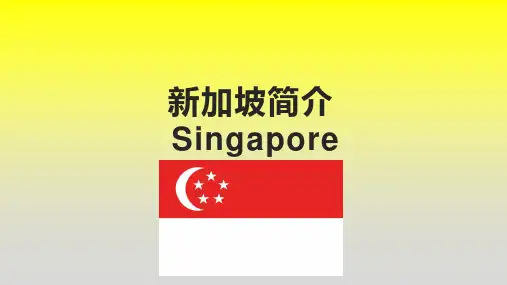
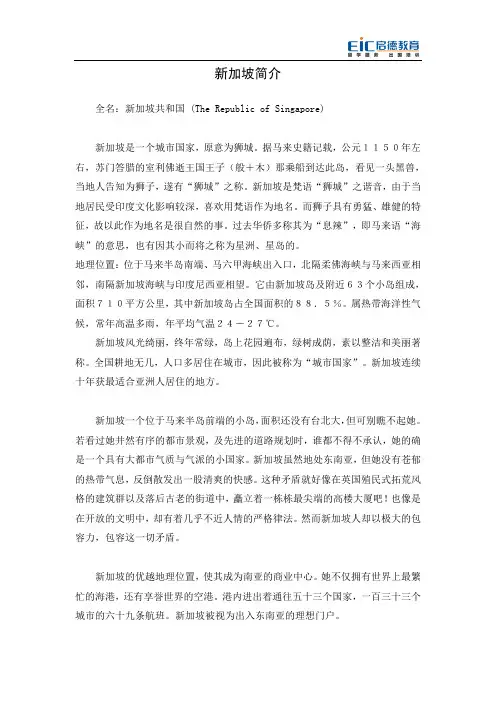
新加坡简介全名:新加坡共和国 (The Republic of Singapore)新加坡是一个城市国家,原意为狮城。
据马来史籍记载,公元1150年左右,苏门答腊的室利佛逝王国王子(般+木)那乘船到达此岛,看见一头黑兽,当地人告知为狮子,遂有“狮城”之称。
新加坡是梵语“狮城”之谐音,由于当地居民受印度文化影响较深,喜欢用梵语作为地名。
而狮子具有勇猛、雄健的特征,故以此作为地名是很自然的事。
过去华侨多称其为“息辣”,即马来语“海峡”的意思,也有因其小而将之称为星洲、星岛的。
地理位置:位于马来半岛南端、马六甲海峡出入口,北隔柔佛海峡与马来西亚相邻,南隔新加坡海峡与印度尼西亚相望。
它由新加坡岛及附近63个小岛组成,面积710平方公里,其中新加坡岛占全国面积的88.5%。
属热带海洋性气候,常年高温多雨,年平均气温24-27℃。
新加坡风光绮丽,终年常绿,岛上花园遍布,绿树成荫,素以整洁和美丽著称。
全国耕地无几,人口多居住在城市,因此被称为“城市国家”。
新加坡连续十年获最适合亚洲人居住的地方。
新加坡一个位于马来半岛前端的小岛,面积还没有台北大,但可别瞧不起她。
若看过她井然有序的都市景观,及先进的道路规划时,谁都不得不承认,她的确是一个具有大都市气质与气派的小国家。
新加坡虽然地处东南亚,但她没有苍郁的热带气息,反倒散发出一股清爽的快感。
这种矛盾就好像在英国殖民式拓荒风格的建筑群以及落后古老的街道中,矗立着一栋栋最尖端的高楼大厦吧!也像是在开放的文明中,却有着几乎不近人情的严格律法。
然而新加坡人却以极大的包容力,包容这一切矛盾。
新加坡的优越地理位置,使其成为南亚的商业中心。
她不仅拥有世界上最繁忙的海港,还有享誉世界的空港。
港内进出着通往五十三个国家,一百三十三个城市的六十九条航班。
新加坡被视为出入东南亚的理想门户。
东西方文化在新加坡交汇。
从百老汇歌剧、经典交响乐、舞台剧、摇滚音乐会到酒吧和夜总会,应有尽有。
如果在一场芭蕾舞演出在此上演,这其中包括Bolshoi的芭蕾舞,意大利著名男高音歌唱家帕瓦罗蒂和美国流行乐坛的偶像人物迈克尔杰克逊的演唱会,以及一些非常著名的音乐剧、如 "猫"、 "悲惨世界"和 "剧院幽魂"。
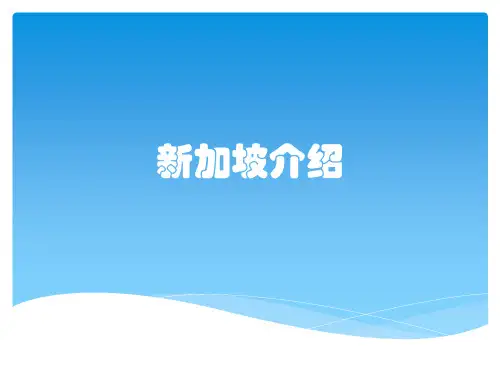
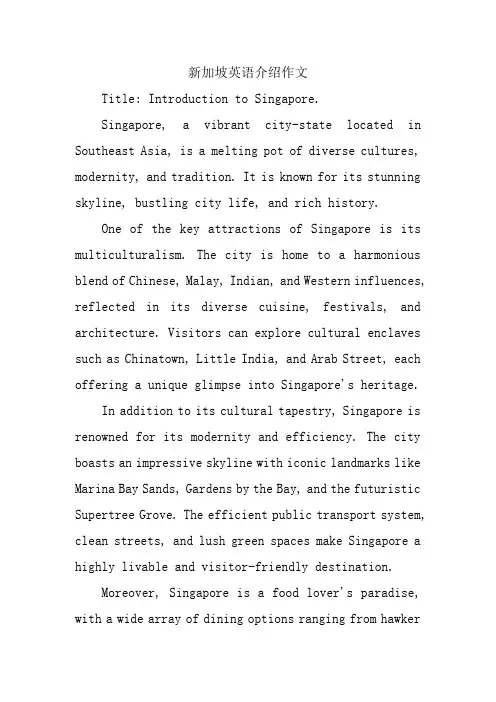
新加坡英语介绍作文Title: Introduction to Singapore.Singapore, a vibrant city-state located in Southeast Asia, is a melting pot of diverse cultures, modernity, and tradition. It is known for its stunning skyline, bustling city life, and rich history.One of the key attractions of Singapore is its multiculturalism. The city is home to a harmonious blend of Chinese, Malay, Indian, and Western influences, reflected in its diverse cuisine, festivals, and architecture. Visitors can explore cultural enclaves such as Chinatown, Little India, and Arab Street, each offering a unique glimpse into Singapore's heritage.In addition to its cultural tapestry, Singapore is renowned for its modernity and efficiency. The city boasts an impressive skyline with iconic landmarks like Marina Bay Sands, Gardens by the Bay, and the futuristic Supertree Grove. The efficient public transport system, clean streets, and lush green spaces make Singapore a highly livable and visitor-friendly destination.Moreover, Singapore is a food lover's paradise, with a wide array of dining options ranging from hawkercenters serving local delights to Michelin-starred restaurants offering gourmet cuisine. The city's culinary scene is a reflection of its multicultural identity, offering a gastronomic journey like no other.In conclusion, Singapore is a dynamic city-state that seamlessly blends tradition with modernity, offering visitors a unique and unforgettable experience. Whether you are exploring its cultural heritage, admiring its futuristic architecture, or indulging in its diverse culinary delights, Singapore has something for everyone.中文翻译:介绍新加坡。
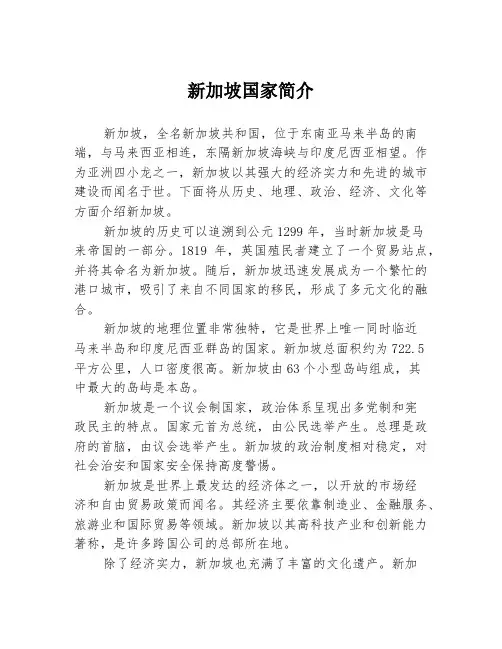
新加坡国家简介新加坡,全名新加坡共和国,位于东南亚马来半岛的南端,与马来西亚相连,东隔新加坡海峡与印度尼西亚相望。
作为亚洲四小龙之一,新加坡以其强大的经济实力和先进的城市建设而闻名于世。
下面将从历史、地理、政治、经济、文化等方面介绍新加坡。
新加坡的历史可以追溯到公元1299年,当时新加坡是马来帝国的一部分。
1819年,英国殖民者建立了一个贸易站点,并将其命名为新加坡。
随后,新加坡迅速发展成为一个繁忙的港口城市,吸引了来自不同国家的移民,形成了多元文化的融合。
新加坡的地理位置非常独特,它是世界上唯一同时临近马来半岛和印度尼西亚群岛的国家。
新加坡总面积约为722.5平方公里,人口密度很高。
新加坡由63个小型岛屿组成,其中最大的岛屿是本岛。
新加坡是一个议会制国家,政治体系呈现出多党制和宪政民主的特点。
国家元首为总统,由公民选举产生。
总理是政府的首脑,由议会选举产生。
新加坡的政治制度相对稳定,对社会治安和国家安全保持高度警惕。
新加坡是世界上最发达的经济体之一,以开放的市场经济和自由贸易政策而闻名。
其经济主要依靠制造业、金融服务、旅游业和国际贸易等领域。
新加坡以其高科技产业和创新能力著称,是许多跨国公司的总部所在地。
除了经济实力,新加坡也充满了丰富的文化遗产。
新加坡的文化多元性体现在各个方面,包括语言、宗教、节日和美食等。
该国的主要民族包括华人、马来人、印度人和欧亚人,各自保留着各自的传统和习俗。
新加坡还拥有许多独特的文化艺术形式,如传统舞蹈、音乐和戏剧。
总之,新加坡是一个历史悠久、多元文化、经济繁荣的国家。
尽管面积较小,但它在世界舞台上扮演着重要的角色。
新加坡的成功离不开其优越的地理位置、稳定的政治制度和发达的经济。
作为一个现代化城市国家,新加坡继续努力保持其国家形象和国际地位。
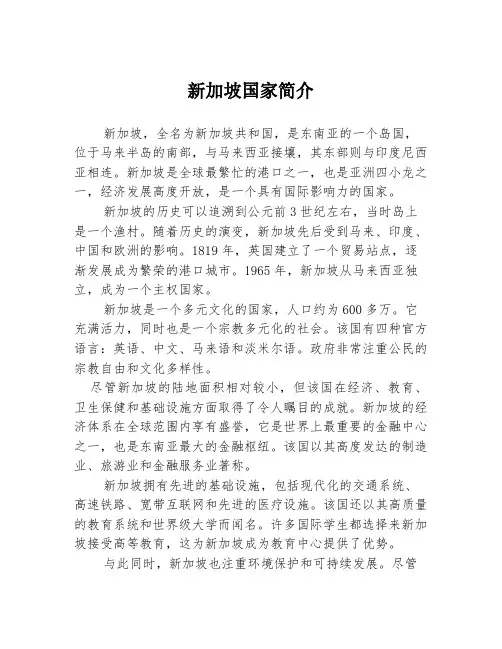
新加坡国家简介新加坡,全名为新加坡共和国,是东南亚的一个岛国,位于马来半岛的南部,与马来西亚接壤,其东部则与印度尼西亚相连。
新加坡是全球最繁忙的港口之一,也是亚洲四小龙之一,经济发展高度开放,是一个具有国际影响力的国家。
新加坡的历史可以追溯到公元前3世纪左右,当时岛上是一个渔村。
随着历史的演变,新加坡先后受到马来、印度、中国和欧洲的影响。
1819年,英国建立了一个贸易站点,逐渐发展成为繁荣的港口城市。
1965年,新加坡从马来西亚独立,成为一个主权国家。
新加坡是一个多元文化的国家,人口约为600多万。
它充满活力,同时也是一个宗教多元化的社会。
该国有四种官方语言:英语、中文、马来语和淡米尔语。
政府非常注重公民的宗教自由和文化多样性。
尽管新加坡的陆地面积相对较小,但该国在经济、教育、卫生保健和基础设施方面取得了令人瞩目的成就。
新加坡的经济体系在全球范围内享有盛誉,它是世界上最重要的金融中心之一,也是东南亚最大的金融枢纽。
该国以其高度发达的制造业、旅游业和金融服务业著称。
新加坡拥有先进的基础设施,包括现代化的交通系统、高速铁路、宽带互联网和先进的医疗设施。
该国还以其高质量的教育系统和世界级大学而闻名。
许多国际学生都选择来新加坡接受高等教育,这为新加坡成为教育中心提供了优势。
与此同时,新加坡也注重环境保护和可持续发展。
尽管土地有限,但新加坡致力于保护自然资源和生态平衡。
该国实施了许多环保政策,包括鼓励可再生能源的使用和提倡垃圾分类。
在文化方面,新加坡有着丰富多样的文化景观。
人们可以欣赏到来自不同文化背景的艺术、音乐和舞蹈表演。
此外,新加坡也是一个购物天堂,拥有各种购物中心和百货商店,满足不同人群的需求。
总之,新加坡作为一个小而富裕的国家,在经济、教育和文化等方面取得了巨大的成就。
它以其高效的政府和健全的制度而闻名,并将继续朝着可持续发展和全球化的道路前进。

新加坡共和国Republic of Singapore位置:Singapore consists of the main island ofSingapore and some 63 offshore islands. It issituated between latitudes 1°09'N and 1°29'Nand longitudes 103°36'E and 104°25'Eapproximately 137 kilometres north of theEquator.新加坡包括新加坡本岛和63个近海岛屿。
它是介于北纬1°09'n和1°29'n和经度103°36'e和104°25'e赤道以北大约137公里。
The official languages in Singapore are Malay, Chinese (Mandarin), Tamil and English. Malay is the national language and English is the language of administration. The Constitution allows every person the right to profess and practise his religion and to propagate it. The main religions in Singapore are Buddhism, Taoism, Islam, Christianity and Hinduism.新加坡的官方语言是中文(普通话),马来语,泰米尔语和英语。
马来语为国语,英语是语言的管理。
宪法允许每个人的信奉和实行自己的宗教宣传它。
主要宗教在新加坡是佛教,道教,基督教,伊斯兰教,印度教。

新加坡介绍新加坡,全名为新加坡共和国,是东南亚的一个城市国家。
作为一个小岛国,新加坡位于马来群岛南端,与马来西亚接壤,隔着柔佛海峡与印度尼西亚相望。
尽管国土面积较小,但新加坡以其先进的经济、现代化的城市规划以及多样性的文化吸引了世界各地的游客。
新加坡是一个富裕而多元化的国家。
其经济实力在东南亚地区颇具影响力,属于世界贸易组织、联合国和英联邦成员国。
作为全球金融中心和国际航运中心,新加坡以其高效的海港和先进的金融市场著称。
此外,新加坡还是一个创新科技中心,积极推动科技产业的发展。
新加坡有丰富的旅游资源。
旅游业是新加坡经济的重要部分,也是国家的主要收入来源之一。
无论是自然风光、文化遗产还是现代化的建筑,新加坡都有许多令人惊叹的景点。
其中,著名的景点之一是新加坡河。
新加坡河是城市的动脉,贯穿了市区的中央商务区。
河两岸有许多历史建筑和文化遗产,如著名的卡雅加沙(Clarke Quay)和颐和园(Boat Quay),游客们可以在这里欣赏到独特的建筑风格和美丽的夜景。
另一个备受游客青睐的景点是滨海湾金沙酒店(Marina Bay Sands)。
这个奢华酒店是新加坡的地标之一,拥有三座独特的屋顶花园和无边际泳池,可以俯瞰整个城市和海湾的壮丽景色。
此外,滨海湾金沙酒店还包括购物中心、博物馆和娱乐场所,是一个集购物、娱乐和文化于一体的综合体。
新加坡还有许多公园和自然保护区,提供了一个逃离城市喧嚣的好去处。
其中最受欢迎的是新加坡植物园。
该植物园是一个巨大的绿洲,拥有世界上最大的热带胡姬花园、热带雨林和各种珍稀植物。
游客可以在这里漫步、野餐或参加植物科普活动,享受大自然的美好。
此外,新加坡还有丰富的美食文化。
由于新加坡是一个多元文化的国家,这里有各种各样的美食选择,包括中餐、马来餐、印度餐和西方美食等。
新加坡的美食以其独特的口味和多样性而闻名,如辣椒螃蟹、炒果条和虾饺等。
无论是在豪华餐厅还是小巷小吃摊,游客都可以品尝到美味的新加坡料理。
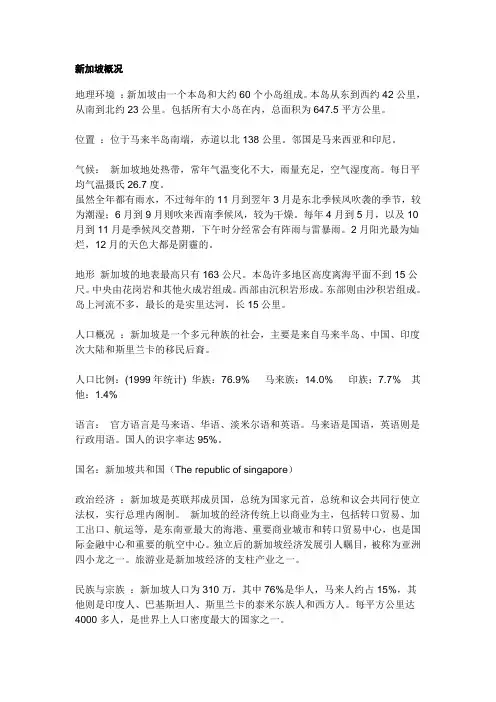
新加坡概况地理环境:新加坡由一个本岛和大约60个小岛组成。
本岛从东到西约42公里,从南到北约23公里。
包括所有大小岛在内,总面积为647.5平方公里。
位置:位于马来半岛南端,赤道以北138公里。
邻国是马来西亚和印尼。
气候:新加坡地处热带,常年气温变化不大,雨量充足,空气湿度高。
每日平均气温摄氏26.7度。
虽然全年都有雨水,不过每年的11月到翌年3月是东北季候风吹袭的季节,较为潮湿;6月到9月则吹来西南季候风,较为干燥。
每年4月到5月,以及10月到11月是季候风交替期,下午时分经常会有阵雨与雷暴雨。
2月阳光最为灿烂,12月的天色大都是阴霾的。
地形新加坡的地表最高只有163公尺。
本岛许多地区高度离海平面不到15公尺。
中央由花岗岩和其他火成岩组成。
西部由沉积岩形成。
东部则由沙积岩组成。
岛上河流不多,最长的是实里达河,长15公里。
人口概况:新加坡是一个多元种族的社会,主要是来自马来半岛、中国、印度次大陆和斯里兰卡的移民后裔。
人口比例:(1999年统计) 华族:76.9% 马来族:14.0% 印族:7.7% 其他:1.4%语言:官方语言是马来语、华语、淡米尔语和英语。
马来语是国语,英语则是行政用语。
国人的识字率达95%。
国名:新加坡共和国(The republic of singapore)政治经济:新加坡是英联邦成员国,总统为国家元首,总统和议会共同行使立法权,实行总理内阁制。
新加坡的经济传统上以商业为主,包括转口贸易、加工出口、航运等,是东南亚最大的海港、重要商业城市和转口贸易中心,也是国际金融中心和重要的航空中心。
独立后的新加坡经济发展引人瞩目,被称为亚洲四小龙之一。
旅游业是新加坡经济的支柱产业之一。
民族与宗族:新加坡人口为310万,其中76%是华人,马来人约占15%,其他则是印度人、巴基斯坦人、斯里兰卡的泰米尔族人和西方人。
每平方公里达4000多人,是世界上人口密度最大的国家之一。
英语、华语、马来语、泰米尔语为官方语言,马来语为国语,政府机关使用英语,英语为行政用语,大多数新加坡人都会使用英语和华语。
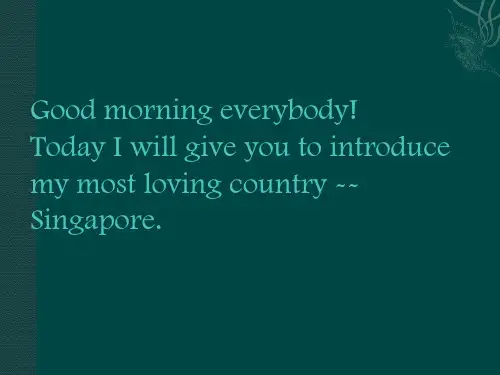

新加坡概况国名:新加坡共和国(The Republic of Singapore)Brief IntroductionSingapore was founded as a British trading colony in 1819. It joined the Malaysian Federation in 1963 but separated two years later and became independent. Singapore subsequently became one of the world's most prosperous countries with strong international trading links (its port is one of the world's busiest in terms of tonnage handled) and with per capita GDP equal to that of the leading nations of Western Europe.Location: Southeastern Asia, islands between Malaysia and IndonesiaArea: total: 692.7 sq km land: 682.7 sq kmClimate: tropical; hot, humid, rainy; two distinct monsoon seasons - Northeastern monsoon (December to March) and Southwestern monsoon (June to September); inter-monsoon - frequent afternoon and early evening thunderstormsTerrain: lowland; gently undulating central plateau contains water catchment area and nature preservePopulation: 4,553,009 (July 2007 est.) Chinese 76.8%, Malay 13.9%, Indian 7.9%, other 1.4% (2000 census)The world's busiest port, the modern nation of the Republic of Singapore, Singapore's location on the major sea route between India and China, its excellent harbor, and the free trade status conferred on it by its visionary founder, Sir Thomas Stamford Raffles, made the port an overnight success. By 1990 the multiethnic population attracted to the island had grown from a few thousand to 2.6 million Singaporeans, frequently referred to by Prime Minister Lee Kuan Yew as his nation's greatest resource. If Raffles had set the tone for the island's early success, Lee had safeguarded the founder's vision through the first quarter-century of Singapore's existence as an independent nation, providing the leadership that turned it into a global city that offered trading and financial services to the region and to the world.Modern Singapore would be scarcely recognizable to Raffles, who established his trading center on an island covered with tropical forests and ringed with mangrove swamps. Towering skyscrapers replace the colonial town he designed, and modern expressways cover the tracks of bullock carts that once led from the harbor to the commercial district and the countryside beyond. Hills have been leveled, swamps filled, and the island itself expanded in size through extensive land reclamation projects. Offshore islands are used for recreation parks, oil refineries, and military training bases. Despite the scarcity of land for real estate, the government has worked to maintain and expand the island's parks, gardens, and other green spaces. By housing 88 percent of its population in mostly multistoried public housing, Singapore has kept a rein on suburban sprawl. In Raffles's town plan, separate areas were set aside for the various ethnic groups of the time: Malays, Chinese, Arabs, Bugis, andEuropeans. Government resettlement programs begun in the 1960s broke up the former ethnic enclaves by requiring that the public housing projects--called housing estates--that replaced them reflect the ethnic composition of the country as a whole. As a result, modern Singapore's three main ethnic groups--Chinese, Malays, and Indians--live next door to each other and share the same housing development facilities, shops, and transportation.Despite efforts to maintain an ethnic balance in housing, however, the stated goal of the nation's leaders is not that Singapore become a mini-melting pot, but, rather, a multiethnic society. Of the country's 2.6 million inhabitants, about 76 percent are Chinese, 15 percent Malay, 6.5 percent Indian, and 2.5 percent other. There are, however, mixtures within this mixture. The designation Chinese lumps together speakers of more than five mutually unintelligible dialects; Singaporean Malays trace their forebears to all of the major islands of the Indonesian archipelago, as well as to the Malay Peninsula; and the ancestral homes of Indians include what are the modern states of India, Pakistan, Bangladesh, and Sri Lanka. Out of this diversity, the government leadership has attempted to establish a what is calls "Singaporean identity," which would include certain unifying and modernizing elements but yet retain essential variations, based on Asian culture and values. One of the unifying factors is the English language, selected as the medium for educational instruction both because of its neutrality in the eyes of the three dominant ethnic groups and because of its position as the international language of business, science, and technology. In order not to lose touch with their Asian heritage, however, Singaporean school children are also required to study an appropriate "mother tongue," designated by the government as either Malay, Tamil, or Mandarin Chinese--a vast oversimplification of the polyglot of Singaporean native languages.Singaporean identity, as envisioned by the country's leadership, calls for rugged individualism with an emphasis on excellence; the government constantly exhorts its citizens to be the best they can be. Education, home ownership, and upward mobility are all considered appropriate goals. Although Singaporeans are expected to be modern in their outlook, they also are encouraged to retain a core of traditional Asian values and culture. In a society in which all share a common education system, public housing, recreation facilities, and military training, the government considers it important to highlight the uniqueness of the three official ethnic groups--Chinese, Malays, and Indians-- through the setting aside of national ethnic holidays and the sponsorship of ethnic festivals. Singaporean ethnic differences are usually maintained, however, not so much by these somewhat self-conscious displays of ethnicity but rather by membership in ethnically exclusive associations. Usually religious, charitable, or business in nature, many of these associations had their origins in colonial Singapore and represent finer distinctions of ethnicity than those supported by the government. Chinese trade associations, for example, are usually restricted to speakers of a particular dialect. Hindu temples are sometimes associated with worshipers who trace their heritage to a particular region of India.Singapore is multireligious as well as multiethnic. Major religious preferences reported in 1988 were Buddhism (28 percent), Christian (19 percent), no religion (17 percent), Islam (16 percent), Daoist (13 percent), and Hindu (5 percent). Singapore's nineteenth-century immigrants valued the social as well as religious aspects of their congregations, and their descendants are more likely to concern themselves with social activities centered around their temples and mosques than with elaborate ritual or ceremony. The government, although secular, views religion as a positive force for instilling moral values in the society. At the same time, it keeps a watchful eye out for social or political activism within religious groups. Muslim fundamentalists and over-zealous Christian proselytizers alike are kept under careful scrutiny, lest they upset the religious and ethnic harmony of the country.Singapore closely resembles developed countries in terms of its low birth rates, high life expectancy (73.8 years at birth), and major causes of death--heart disease, cancer, and stroke. Although in the early years of independence the government mounted campaigns to lower the country's high birth rate, it became concerned in the 1980s when the rate dropped below the replacement level. Campaigns and incentives were instituted to encourage those who could afford it to have more than two children. College-educated women were especially encouraged by exhortations and incentives to marry and have children.In terms of public health, Singapore also closely resembles developed countries. A network of superhighways and a state-of-the-art mass rapid transit system connect Singapore's housing estates with commercial and industrial areas.Although Singapore's founder and other nineteenth-century residents would no longer recognize the island, they would at least be able to identify with certain aspects of its modern economy.In 1990 the economy of modern Singapore was still based on the same services that were performed by the colonial port, although most of these services had been greatly expanded or modified and new ones added. The major sectors of the economy were the regional entrep trade, export-oriented manufacturing, petroleum refining and shipping, production of goods and services for the domestic economy, and a vastly expanded services industry.When independence was suddenly thrust upon Singapore in 1965, its economic prospects looked bleak, if not precarious.不稳定的In the aftermath of World War II, Singapore had faced staggering problems of high unemployment, slow economic growth, inadequate housing, decaying infrastructure, and labor and social unrest. Separation from Malaysia meant the loss of its economic hinterland, 内地贸易区and Indonesia's policy of military Confrontation directed at Singapore and Malaysia had dried up the entrap trade from that direction. Moreover, with the announcement in 1968 of Britain's departure from the island's bases, Singapore faced the loss of 20 percent of its jobs. These problems led Singapore's leadership to take a strong role in guiding the nation's economy. The governmentaggressively promoted export-oriented, labor-intensive industrialization through a program of incentives designed to attract foreign investment. By 1972 one-quarter of Singapore's manufacturing firms were either foreign-owned or joint-venture companies, with the United States and Japan both major investors. The response of foreign investors to Singapore's favorable investment climate and the rapid expansion of the world economy at that time were factors in the annual double-digit growth of the country's GDP during most of the period from 1965 through 1973. By the late 1970s, however, government planners had adopted a policy of replacing Singapore's labor-intensive manufacturing with skill- and technology-intensive, high value-added industries. Information technology was particularly targeted for expansion, and by 1989 Singapore was the world's largest producer of disk drives and disk drive parts. In that year, earnings from manufacturing accounted for 30 percent of the country's GDP.Although Singapore lost its former hinterland 内地贸易区when it separated from Malaysia, its northern neighbor remained the leading source of primary imports and a major destination for Singapore's manufactured exports. Malaysia was Singapore's third largest overall trading partner in 1988, and Singaporean companies were major investors in Malaysia's southern state of Johor. The entrep魌trade with Indonesia had long since revived following the end of Confrontation in 1966. By the late 1980s, Singapore was the world's third largest petroleum-refining center as well as third largest oil-trading center, serving the needs of oil-rich Indonesia and Malaysia. By 1988 Singapore had nosed out Rotterdam as the world's busiest port in terms of tonnage. Some 700 shiplines used its modern facilities each year, including Singapore's own merchant fleet, which ranked fifteenth worldwide. Four major shipyards employed about 70,000 workers, about 40 percent of whom were from neighboring Asian countries.One of the fastest growing sectors of the economy was Singapore's international banking and financial services sector, which accounted for nearly 25 percent of the country's GDP in the late 1980s. Historically, Singapore served as the financial services center for Southeast Asia, and in the late 1980s it ranked with Hong Kong as the two most important Asian financial centers after Tokyo.In late 1989, Lee announced that he would step down in late 1990 and that his successor, First Deputy Prime Minister Goh Chok Tong, had already largely taken over the day-to-day management of the government. However, based on the prime minister's own assertions that he was not yet ready to relinquish all control, observers speculated on just what powers Lee would continue to hold. Goh acknowledged in late 1989 the growing sophistication and rising expectations of younger Singaporeans, who want a greater participation in the country's political life, and noted that he expected the opposition to claim a larger share of seats in parliament in the 1990s. In contrasting his leadership style with that of Lee, Goh stated that Lee "believes in firm government from the center . . . whereas our style is a little moreconsultative, more consensus-building." Behind Goh in the Singapore leadership queue was believed to be Lee Kuan Yew's son, Brigadier General Lee Hsien Loong, who served in the cabinet as minister for trade and industry and second minister for defence. His meteoric rise in the late 1980s through the ranks of bureaucratic and political responsibility was regarded with interest by both foreign and domestic observers.In August 1989, Lee Kuan Yew created a stir within the region by stating that Singapore was "prepared to host some United States facilities to make it easier for the Philippines to host the United States bases there." Malaysia reacted negatively to the announcement, and other ASEAN countries expressed some dismay. In October, however, the Singapore foreign ministry clarified the issue by stating that an increased use of Singapore's maintenance and repair facilities by United States ships had been agreed on by the two countries, as had short-term visits by United States aircraft to Singapore's Paya Lebar Air Base. The agreement followed a period of somewhat strained relations between the two nations, during which the United States had been critical of Singapore's use of its Internal Security Act to detain dissidents indefinitely, and Singapore had accused Washington of meddling in its internal affairs. The United States, however, was Singapore's largest trading partner and foreign investor, and the relationship was one that neither country was eager to upset.By the last decade of the twentieth century, the former colonial port of Singapore had become a global financial, trading, and industrial center that continued to live by its wits in the world of international trade, just as it had done in the nineteenth century. Singapore's leadership and its people have always managed to adapt to the changing demands of the world economy, on which so much of their livelihood depended. In the coming decade, however, a new generation of leaders will take full control of the nation's government and economy. Before them lies the task of reconciling the need to steer a steady course in the nation's continuing development with the people's growing aspirations for an increased share in political and economic decision making.March 17, 1990 Barbara Leitch LePoer Data as of December 1989 国名来由:新加坡是一个城市国家,原意为狮城。